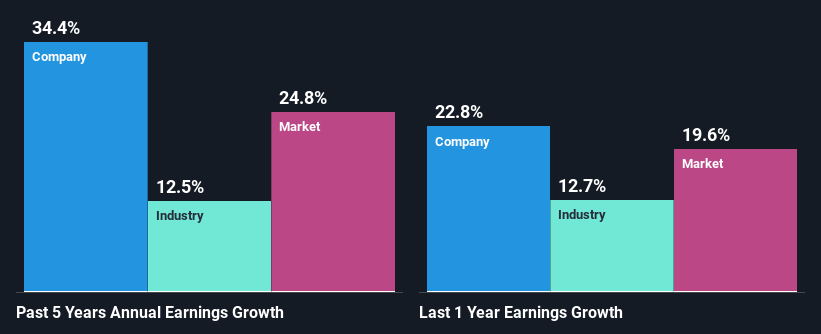Xpro India Limited's (NSE:XPROINDIA) Fundamentals Look Pretty Strong: Could The Market Be Wrong About The Stock?
Xpro India (NSE:XPROINDIA) has had a rough three months with its share price down 27%. However, stock prices are usually driven by a company’s financials over the long term, which in this case look pretty respectable. Specifically, we decided to study Xpro India's ROE in this article.
ROE or return on equity is a useful tool to assess how effectively a company can generate returns on the investment it received from its shareholders. In other words, it is a profitability ratio which measures the rate of return on the capital provided by the company's shareholders.
How To Calculate Return On Equity?
ROE can be calculated by using the formula:
Return on Equity = Net Profit (from continuing operations) ÷ Shareholders' Equity
So, based on the above formula, the ROE for Xpro India is:
7.6% = ₹439m ÷ ₹5.8b (Based on the trailing twelve months to December 2024).
The 'return' refers to a company's earnings over the last year. Another way to think of that is that for every ₹1 worth of equity, the company was able to earn ₹0.08 in profit.
Check out our latest analysis for Xpro India
What Has ROE Got To Do With Earnings Growth?
Thus far, we have learned that ROE measures how efficiently a company is generating its profits. Based on how much of its profits the company chooses to reinvest or "retain", we are then able to evaluate a company's future ability to generate profits. Generally speaking, other things being equal, firms with a high return on equity and profit retention, have a higher growth rate than firms that don’t share these attributes.
Xpro India's Earnings Growth And 7.6% ROE
As you can see, Xpro India's ROE looks pretty weak. Even when compared to the industry average of 10%, the ROE figure is pretty disappointing. However, we we're pleasantly surprised to see that Xpro India grew its net income at a significant rate of 34% in the last five years. We believe that there might be other aspects that are positively influencing the company's earnings growth. For instance, the company has a low payout ratio or is being managed efficiently.
As a next step, we compared Xpro India's net income growth with the industry, and pleasingly, we found that the growth seen by the company is higher than the average industry growth of 13%.

Earnings growth is a huge factor in stock valuation. The investor should try to establish if the expected growth or decline in earnings, whichever the case may be, is priced in. By doing so, they will have an idea if the stock is headed into clear blue waters or if swampy waters await. Is Xpro India fairly valued compared to other companies? These 3 valuation measures might help you decide.
Is Xpro India Using Its Retained Earnings Effectively?
Xpro India's three-year median payout ratio to shareholders is 7.8%, which is quite low. This implies that the company is retaining 92% of its profits. So it looks like Xpro India is reinvesting profits heavily to grow its business, which shows in its earnings growth.
Besides, Xpro India has been paying dividends over a period of three years. This shows that the company is committed to sharing profits with its shareholders.
Conclusion
Overall, we feel that Xpro India certainly does have some positive factors to consider. Even in spite of the low rate of return, the company has posted impressive earnings growth as a result of reinvesting heavily into its business.
Have feedback on this article? Concerned about the content? Get in touch with us directly. Alternatively, email editorial-team (at) simplywallst.com.
This article by Simply Wall St is general in nature. We provide commentary based on historical data and analyst forecasts only using an unbiased methodology and our articles are not intended to be financial advice. It does not constitute a recommendation to buy or sell any stock, and does not take account of your objectives, or your financial situation. We aim to bring you long-term focused analysis driven by fundamental data. Note that our analysis may not factor in the latest price-sensitive company announcements or qualitative material. Simply Wall St has no position in any stocks mentioned.
 Index Options
Index Options CME Group
CME Group Nasdaq
Nasdaq Cboe
Cboe TradingView
TradingView Wall Street Journal
Wall Street Journal